Rick's b.log - 2011/07/29
You are 18.188.175.66, pleased to meet you!
Rick's b.log - 2011/07/29 |
|
| It is the 21st of November 2024 You are 18.188.175.66, pleased to meet you! |
|
mailto: blog -at- heyrick -dot- eu
A little bit of history: you might be surprised if you obtain a deck and find it in a cute little Nintendo box, as pictured above.
If you decide to watch this film, and I recommend it, don't be put off by the complicated-looking "virtual world" shown in the beginning. The virtual world occupies about a fifth of the movie. It is a rather sweet and engaging film, somewhat in the Ghibli tradition.
Traditional Western playing cards have four suits in two colours (hearts and diamonds for red, spades and clubs for black), and they are numbered with Ace being 1 (or a high card, depending on the game) plus Jacks/Knaves, Queens, and Kings. There are also, for some games, two Joker cards.
By contrast, Hanafuda consists of twelve suits of four cards. Each suit carries a botanical theme (willow, cherry blossom, chrysanthemum...) which also relates to a month of the year. Indeed, Hanafuda translates as "flower cards".
As with Western playing cards, each card nominally carries a value. I say nominally, for the value of the card is not used in Koi-koi, for you gain points by the combinations made. These combinations are called "yaku".
Within these suits, there are five different sorts of card:
Now we shall look at the cards suit by suit.
The "dealer" is selected by whatever method suits the players. The dealer shuffles, the other cuts, and so on.
The cards are then dealt in a specific manner:
Before play, the cards dealt face up should be examined, as follows:
There are two instant win conditions for a dealt hand. These are:
Some assume that the dealer will play first. I prefer the variation where both players take a card from the top of the stack (dealer first). Whoever has a card from the earliest month in the year will be the first to play. [those two cards are then reinserted into the stack]
Playing
Each player plays in turn. A turn consists of the following two actions:
Firstly, a player takes a card from their hand and places it, face up, into the centre area of the table.
Next, you take the next card off of the stack, and look to see if it matches a card in the centre. If it does, place it on top to capture the card, otherwise place it alongside.
Finally, if you have captured any cards, you should now take these and place them into your playing area face up (the right hand side, by tradition), and organised according to their classment (brights, animals, ribbons, plains).
The strict rules state that a match must be made if it is possible. However I prefer to play with the more stretegic approach that a match must be made only with the card drawn from the stack. If you choose not to make a match from the cards in your hand, for whatever reason, then you don't need to.
As you might have guessed, this game mixes luck with skill. Don't just haphazardly match cards, you're looking to get the cards that will gain you a yaku.
Errors
It may be that a player commits an error - either in placing a card and not recognising a match, or forgetting to take a card from the pile. My personal take on this is that if a match was not noticed, the player can correct this while it is still that player's move. In other words, if they've just taken and placed the card from the stack and they think "hang on!", they can do something about it.
If you decide to be more lenient in your game, keep in mind that if allowing a player to correct a move later on could dramatically alter the game - will you be willing to undo your moves to give them their rightful card? Or will you be happy if the card you were waiting for to complete your bonus yaku ends up in their hands when it would have otherwise been yours? To say a missed opportunity is forfeit seems to me to be the best solution.
Koi-koi!
At the point when any player makes a "Yaku", a winning combination, the game pauses.
The player must then decide to say "Stop" to stop and win the game with however many points they have, or "Koi-koi" to continue playing to aim for more yaku and more points.
Ready?
Okay. With every Koi-koi, the scoring increases. One koi-koi and scores double. Two Koi-koi and scores triple, and so on.
Some variations of the game take it a stage further in that if a player calls "Koi-koi" and then loses, the amount won by the winning player is deducted from the losing player's score. You might want to leave that one until you're an expert player...
In a nutshell: Koi-koi offers you two options - to come up with love bubbles around your head and animated kittens frolicking at your feet... or to crash and burn horribly. Your strategy, and a big dose of luck, decides how the game will turn out.
Yaku / scores
I've noticed that sites seem to be all over the place regarding scoring, so here are the official scores from the little instruction sheet included in my Nintendo Hanafuda, which we can probably consider to be a more authorative source...
There are two ways of scoring:
Scoring ONLY takes place when a player says "stop". The yaku are counted, in all possible permutations, and added up. If any multiplier is in play, this is used to arrive at the final score. The person who said "stop" takes the game, the other player wins nothing.
Basic strategies
You can use the Plain cards to match - matching goes by suit alone. So if you have a plain pampas and the full moon in on the table (or vice versa in your hand), go for it.
Cards matched and placed on the right are "safe".
To a degree, valuable cards in your hand are also safe. There may be no match at the moment, but a suitable card may come up. But don't leave it too long, you can't yaku from unplayed cards.
Aim to take the Saké Cup - it is important!
A risky strategy for playing an important card if you have a match in your hand but there is no match on the table is to place the lower value card on the table as a 'discard'. When it is your next turn, you place the other card and match it to the one you placed earlier. This is risky as the other person may match the initial card, or the cards drawn from the stack may match, leaving you with a potentially unplayable card.
Don't dispair if you were looking for poetry ribbons and your opponent nabs the final one. You can still form other yaku (five ribbons, for example).
Pay attention not only to yourself, but to the cards the opponent plays.
Don't aim for the Brights. They're good points, but there are alternatives.
And finally, nobody in their right mind would declare Stop on a single-point yaku except to block their opponent winning with a bigger yaku score. Otherwise, just say koi-koi for if you lose, you pass up a single point. But you could win a fair bit more. It's worth it.
Practice, practice, practice!
There's only one way it'll make sense to you. That's if you play. Often. Find a willing opponent and go for it whenever it is convenient. [actually, truth be told, finding a Hanafuda deck might be more difficult than finding an opponent!]
Looking at the cards, in the centre of the table is one animal - the Deer, and two brights - Rain Man and Full Moon. Meanwhile, in my hand are two animal cards - Geese and Swallow, one Bright - the Sakura Curtain, and two red Ribbons, one being a poetry ribbon.
Having won the selection, I go first. I take my Willow Swallow and match it to capture the Rain Man.
I turn the top card on the stack. It is Pampas Grass. I can match this with the Full Moon Bright to capture it.
The captured cards are now 'safe', so I have moved them to the lower right of my part of the play area. As you can see, I have arranged them by type - one Plain, a Animal, and two Brights.
This ends my turn.
Back to my turn, I use my Sakura Curtain (a Bright) to match the Cherry blossom Plain on the table, and I turn over an Animal - the Dock - from the stack. The Dock is an Iris card, which matches the Iris card in the centre of the table.
At this point, my safe area will now contain two Animals (Deer and Swallow), three Brights (Full Moon, Curtain, and Rain Man), and some Plains. While I have three Brights, one of them is the Rain Man, so there is no Yaku yet.
For my opponent's turn, a Maple Blue Ribbon matches with a Maple Plain. The next card on the stack is an Iris Plain, which matches nothing, so it remains in the centre of the table.
For my turn, the Iris just placed by my opponent conveniently matches my Iris Red Ribbon, so I play that card. Then I take a card from the stack, which is the Phoenix Bright, matching the Paulownia in the centre of the table.
My turn is not over yet!
If you look at my 'safe' cards, you'll see that I have three Brights and the Rain Man, highlighted in the ever-so-slightly enhanced photo below. This is a Rainy Four Bright, a yaku worth seven points.
I can look over and see my poor opponent has one Animal and One Ribbon. I have a good number of cards to play, and I have plenty of 'safe' cards, although there is nothing 'in the waiting'.
I will, however, look to see if I can gain a few more points, so I shall call...
But I am very aware that if my opponent should form a yaku, even a single point yaku, then the choice of Stop or Koi-koi is theirs to make. If the game is stopped, they gain a single point, and I lose everything. But fingers crossed!
Here is the game area at this time:
And the game continues in the manner shown.
My opponent, however, thinks that I might have fixed things in order to get a good Yaku without two dozen photos. I deny any such ridiculous allegation, but my opponent isn't buying my excuses...
All said and done, if I can encourage just one or two of my readers to seek out this interesting game, it'll have been worthwhile. ☺
Hanafuda Koi-koi
Hanafuda is a Japanese deck of playing cards, and Koi-koi is a popular, and fairly simple, game played with these cards.
The cards themselves are a lot smaller than a Western playing card, about a third of the size, and they are a fair bit thicker. They don't bend, but they do provide a very satisfying 'snap' sound when you're engaged in a game. Shuffling them can be... tricky.
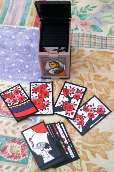
You think Nintendo started with "Donkey Kong"? Nope! Nintendo started in 1889 as a producer of hanafuda cards (complicated story involving Japan's prohibition against gambling). The name "Nintendo", according to Wiki, roughly translates as "leave luck to heaven"!
How I found out about this
It's a fairly important plot point in the animated film "Summer Wars". It seemed an interesting game, which didn't look too difficult to master, yet offered endless strategy options.
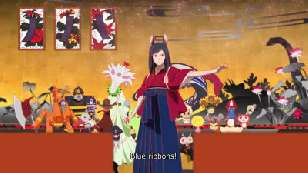

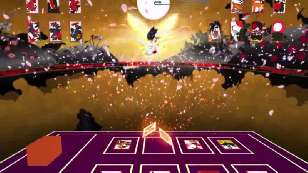
The Hanafuda cards
Perhaps the most complicated thing about Hanafuda are the cards.
These are the rarest with only five in the deck, and most special card, and hence the best for winning points.
A special Bright is the Rain Man.
Here are the Brights, and note that animals feature in some of them:

Phoenix, Rain Man, Full Moon, Curtain, Crane.
These are animal cards, the second most important card. There are nine of them. Note, also, that some of the animal cards don't contain animals in them. Here they are:
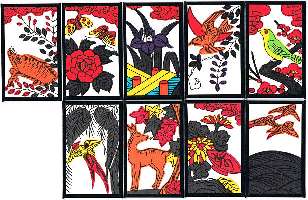
Top row: Boar, Butterflies, Dock, Cuckoo, Nightingale
Bottom row: Swallow, Dear, Saké Cup, Geese.
There are 10 ribbon cards, three plain blue, three red with writing on them, and four plain red. The January and February ribbons (the two on the left in the picture below) say "akayoroshi", the meaning of which is unknown (and if you want to read it from my scans/photos, be aware that it uses hentaigana). The March, Cherry Blossom, ribbon says "Miyoshino" which is a town in Nara well known for spectacular Sakura.
Here are the ribbons:
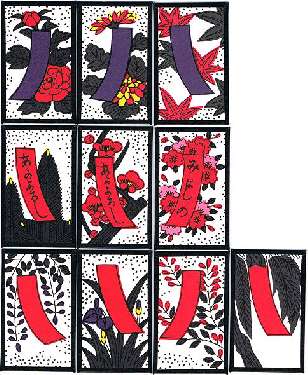
The least important card, the plains make up the remainder of the deck. Each is different, although the suit-related plains are vary similar.
While this may seem unimportant, they can be used to match important cards, plus collecting 10 is a low-grade yaku.

Bright (Crane), Poetry Ribbon, Plain, Plain
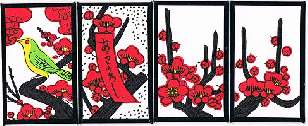
Animal (Nightingale), Poetry Ribbon, Plain, Plain
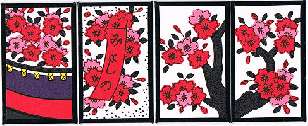
Bright (Curtain), Poetry Ribbon, Plain, Plain
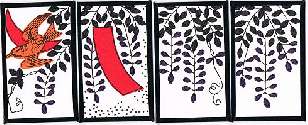
Animal (Cuckoo), Red Ribbon, Plain, Plain
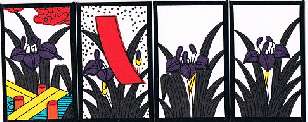
Animal (Dock!), Red Ribbon, Plain, Plain
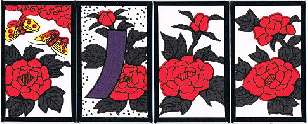
Animal (Butterflies), Blue Ribbon, Plain, Plain
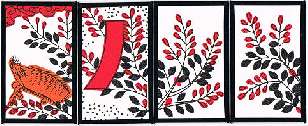
Animal (Boar), Red Ribbon, Plain, Plain
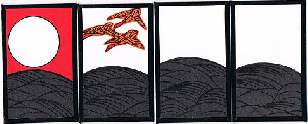
Bright (Full moon), Animal (Geese), Plain, Plain
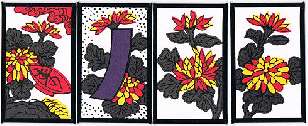
Animal (Saké Cup!), Blue Ribbon, Plain, Plain
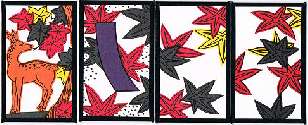
Animal (Deer), Blue Ribbon, Plain, Plain

Bright (Rain Man), Animal (Swallow), Red Ribbon, Plain
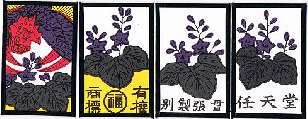
Bright (Phoenix), Plain, Plain, PlainPlaying Koi-Koi
Koi-koi is a game for two players.
You should also note carefully which cards are present, and how they correlate to the cards in your hand.
If the card matches the suit of a card already face up on the table, you should place your card on top of it to "capture" it. You do not pick the cards up yet.
If there are no matching cards, your card is placed alongside the other cards.
However, once the player has indicated their turn is over and the opponent begins play, anything that should have happened is forfeit. Learn from your mistakes!
Saying "Stop" is a safe move, but it may take many hands to reach the target score of 50 points.
Saying "Koi-koi", which means "come on", is when the excitement happens.
HOWEVER, if the opponent scores a yaku and says "Stop", they win the hand. Your previous Koi-koi and points they would have won count for nothing.
Additionally, if a player uses all the cards in their hand, the game is a draw. Nobody wins (previous Koi-koi are ignored). The dealer remains the same for the next game to be played.
Winning combination Points Ten Plain cards - Kasu
(any ten Plains) 1
![]()
...each additional Plain card 1 Five Animal cards - Tane
(any five) 1
![]()
...each additional Animal card
1 Five Ribbon cards - Tanzuku
(any five) 1
![]()
...each additional Ribbon card
1
All three red poetry Ribbons - Akatan 5
![]()
All three blue Ribbons - Aotan 5
![]()
Boar, Deer, Butterflies - Inoshikachō 5
![]()
Dry Three Bright (without Rain Man) - Sankō
(any three except Rain Man) 5
![]()
Saké Cup and Curtain - Hanami-zaki 5
![]()
Saké Cup and Full Moon - Tsukimi-zaki 5
![]()
- note: Tsukimi-zaki and Hanami-zaki can be combined...
Rainy Four Bright (with Rain Man) - Ame-Shikō
(any three, with Rain Man) 7
![]()
Dry Four Bright (without Rain Man) - Shikō 8
![]()
All blue and poetry Ribbons - Aotan no Chōfuku 10
![]()
Five Bright (all five Brights) - Gokō 10
![]()
The following does not appear to be an official Yaku, but is frequently described, so you may wish to include it: All four cards of a suit - Tsukifuda 5
![]()
The yaku are combinational. For example, if you have all five Brights, you get twenty three points - as follows:
[you don't count the Rainy Four Bright in the above as it is worth a point less then the Dry Four Bright which you can make]
Likewise, Saké Cup, Curtain, and Full Moon count as "Saké Cup and Curtain" and "Saké Cup and Full moon", both being five points to give you a total of 10 points.
And, finally, a Dry Four Bright actually scores 13 (5 for a Dry Three, and the 8 for a Dry Four).
A card can form multiple Yaku, but when forming Yaku, only the highest value Yaku is counted. For example, if a person has all the Cherry blossom cards, the other four Brights, and the Saké Cup, this would count as All cards in a suit, Five Bright, and Saké-Curtain. In this case, the Cherry Bright (curtain) forms a part of all three Yaku, but the Five Bright does not also include points for Three and Four Bright combinations; thus this method of calculating scoring is a lot easier.
The Saké+Curtain and Saké+Full Moon can be combined, as they are separate Yaku with a card in common.
Play finishes when a player arrives at 50 points.
Related - the Rain Man isn't necessarily as useful as he might seem as he can only be used once you have three other Bright cards.
The official rules
Here are scans of the official rules leaflet. In Japanese!
Click the small picture for a larger version:
Hint - the Kanji that looks like an iron with steam coming out of it ('点') means "points", which may be enough that you can do a very basic interpretation of the score sheet (the tall one).
Game walkthrough
Here is a walk-through of an example game. The cards are laid out on the table so make things clearer, however note that you do not show your hand (for this reason, my opponent's hand will be obscured).
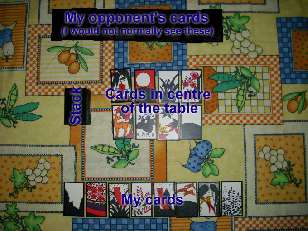
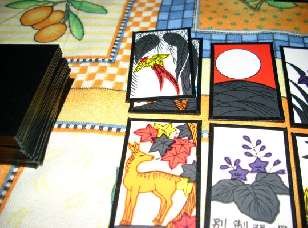
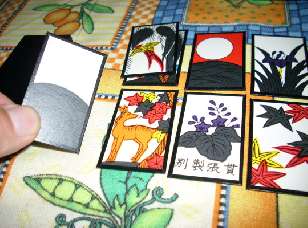
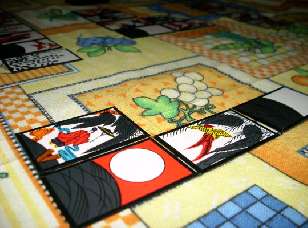
My opponent uses a Maple leaf Plain to capture the Deer Animal, and turns over a Pine Plain from the stack. The two Maple cards are placed in the 'safe' area of my opponent, however the Pine Plain, having matched nothing, remains in the centre of the table.
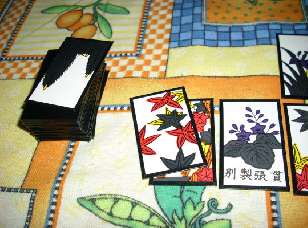

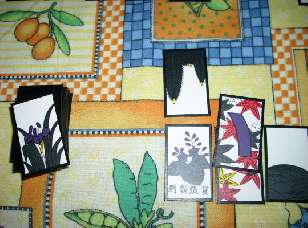
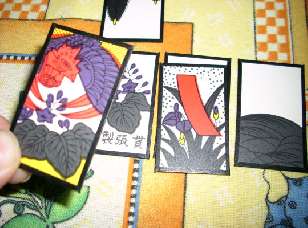
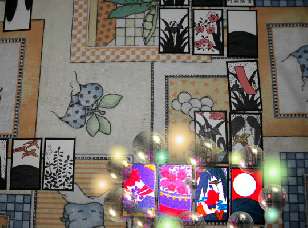
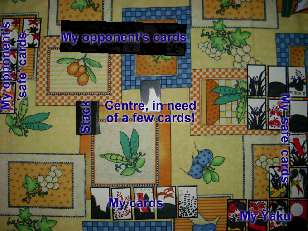
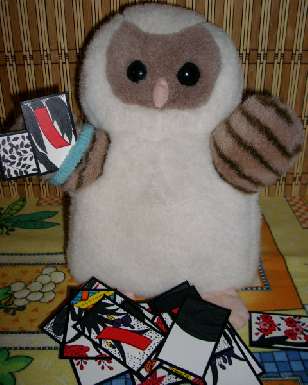
And...
And there you have it. I think this is my most in-depth b.log entry ever, plus one of the longest to write (two and a half days) plus the research involved (four days) plus learning it myself and teaching mom so I have somebody to play.
What annoys me the most, I think, is that mom totally kicks my ass. She was pleasantly surprised with her first win (as shown in the photo), but this trend continued such that I'm thinking of blowing a month's pay to drag mom to Japan where she can gamble her way to a fortune... But maybe mom cheats? Check out the evidence in the photo on the right. Two brains are better than one, right? Even if one is furry, uninterested in the game, and thinking little more than "feed me!"...


joe, 31st July 2011, 10:21
I on the other hand, have to print the lot and learn.
Why don't you just start writing books, you have got
this gift and don't forget to start on "The Ultimate Machine Language Manual", half of the planet is waiting for it.Adrien, 6th December 2012, 22:59 Fred, 27th August 2018, 21:46
I thought you might be interested in this hanafuda games rulebook and thought I would share the link. It’s a hanafuda rulebook with very in-depth rules for 37 different games you can play using hanafuda.
http://kck.st/2v2hcvd
And an earlier edition of the book is on Amazon.
https://tinyurl.com/y9xzqso2
They also have poker-sized hanafuda cards and a fusion deck that has both poker pips and hanafuda symbols! so you can play western card games with them too.Bryce, 18th December 2018, 00:46
| © 2011 Rick Murray |
This web page is licenced for your personal, private, non-commercial use only. No automated processing by advertising systems is permitted. RIPA notice: No consent is given for interception of page transmission. |